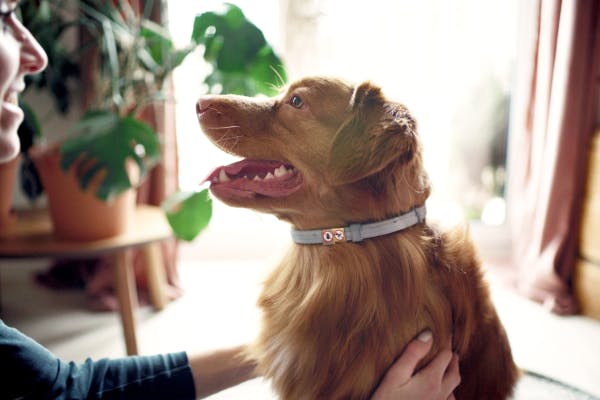learn about martingale collars for dogs
Martingale Collars for Dogs: Advantages, How to Use, and Safety
Martingale collars for dogs provide improved control on walks, stop slipping out, and can be a secure training tool. But, they might cause choking risks if not used right and aren't appropriate for all dog breeds.

Martingale collars, also called no-slip or limited-slip collars, are made to give more control during walks without choking the dog. They are especially useful for dogs with thin heads like Greyhounds and Whippets, but can also help various breeds and sizes. When used right, these collars can boost control, stop slipping out, and work as a training tool.
Understanding Martingale Collars: Knowing Your Dog's Needs
Taking care of a dog includes choosing the right collar. The martingale collar has become popular among dog owners because it helps prevent dogs from slipping out of their collars.
What is a Martingale Collar?
A martingale collar, also called a no-slip or limited-slip collar, is made to stop dogs from getting out of their collars. It looks like a flat collar but has an extra loop that tightens when the dog pulls on the leash. This gives more control without choking the dog.
The special design of this collar lets it tighten just enough to stop escape but not enough to choke the dog. This makes it safer than choke collars, which can tighten too much and hurt the dog.
Who Should Use Martingale Collars?
Martingale collars were first made for dogs with narrow heads like Greyhounds and Whippets because their heads are smaller than their necks. But these collars have been helpful for many breeds and sizes.
They work well for dogs who often back out of their collars or need more control during walks. Many rescue groups also use martingale collars as extra collars for better safety during walks.
Choosing and Fitting a Martingale Collar
Martingale collars come in different widths for different breeds and sizes. For narrow-headed breeds like Greyhounds, wider and padded martingales give more safety and comfort.
To make sure the collar fits well, measure around your dog's neck just behind the ears. This size should match the size of the fully tightened or closed collar. After you pick the right size, adjust the fit so there is about two-finger width's distance between the two sides when pulled.
Using Martingale Collars Safely
Martingale collars are good for stopping dogs from slipping out during walks, but they are not meant for dogs who always pull on their leashes. If used with these dogs, they would have tight collars all the time, which can be uncomfortable.
It is best to use these collars only during walks and take them off at home because of possible risks with loose designs and rings that could get caught on things around them.
Knowing your dog's needs is important when deciding to use a martingale collar. These collars can give more control during walks without hurting the dog if used correctly and based on your dog's behavior.
The Benefits of Using Martingale Collars for Dogs
Martingale collars, also known as greyhound or whippet collars, are a popular choice among dog owners because of their unique design and functionality. These collars provide a mix of control and comfort that can greatly improve your dog walking experience. Here are some advantages of using martingale collars for your dog.
Enhanced Control
Martingale collars are designed to tighten when a dog pulls on the leash, giving the owner better control over the pet during walks. This tightening action discourages pulling behavior, making walks more enjoyable for both you and your pet.
Prevents Slipping Out
One of the main benefits of martingale collars is their ability to stop dogs from slipping out. This is especially helpful for breeds with slim heads and thicker necks, such as greyhounds or whippets, who can easily slip out of traditional collars.
Safety
Martingale collars can be a safe option when used correctly. They should be adjusted so that even at their tightest point, they do not choke your dog. At its loosest, the collar should not be able to slip over your dog's head.
Training Aid
The design of martingale collars makes them an effective training aid. The tightening action when a dog pulls on the leash can help teach them to respond to gentle pressure without causing discomfort.
Prevents Fur Damage
Martingale collars are designed in a way that they prevent fur damage and matting that can happen with traditional collars. This makes them a good option for dogs with long hair.
Stylish and Customizable
In addition to their functional benefits, martingale collars also come in various colors, patterns, and materials allowing pet owners to choose one that suits their pet's personality and style.
Martingale collars offer several benefits that make them an excellent choice for many dogs. However, it's essential always to prioritize your pet's comfort and safety while choosing any collar or harness.
best martingale collars for dogs
- our rating91 out of 100
- our rating89 out of 100
- our rating88 out of 100
Cons to Think About Before Choosing a Martingale Collar
Martingale collars also have some drawbacks. These cons should be thought about before choosing a martingale collar for your dog.
Choking Hazard
Martingale collars are made to give a secure fit without choking your dog, but they do tighten when pulled. This means that if not watched and adjusted carefully, there is a higher risk of choking. This kind of collar is not suggested for wearing without supervision or with retractable leashes, which make dogs pull more.
Correct Usage is Important
The safety and how well martingale collars work depend a lot on using them properly. The collar should be adjusted so that even when it is tightest, it does not choke your dog. When the collar is at its loosest, it should not be able to slip off your dog's head. Using it wrong can possibly hurt your dog.
Not Good for All Dogs
Martingale collars are very helpful for sighthounds with thin heads and thicker necks, but they might not be the best choice for all breeds or sizes of dogs. Other kinds of collars or harnesses could give more control or safety based on what your dog needs.
Material Choices
Martingale collars come in different materials like nylon, leather or metal each with their own good and bad points. For example, while nylon is strong and cheap, some dogs might be allergic to it.
Not the Best for Training
Even though martingale collars can help handle dogs that pull on the leash, they don't always stop this behavior in the long run. They might not help much with teaching the dog not to pull.
While martingale collars can be safe and work well when used right and for the right reasons, it's important to think about these possible downsides before deciding if one is the best choice for your dog.
How to Use a Martingale Collar Safely and Effectively
A martingale collar is a special type of dog collar that offers more control over the dog without the choking risk of a traditional collar. Here's how to use one safely and effectively:
Understand What a Martingale Collar Is: Also known as no-slip or limited-slip collars, martingale collars are designed to stop dogs from backing out or slipping from their collars. They have two loops: a larger one that goes around the dog's neck and a smaller one for attaching the leash. When tension is applied, like when the dog pulls on the leash, the smaller loop tightens, pulling the larger loop tighter around the neck but not too tight to choke.
Know When to Use It: Martingale collars are often used with dogs whose heads are narrower than their necks, like Greyhounds, Whippets, Salukis, and other slim-headed breeds. They're also useful for any dog who tends to back out of their collar or for pet owners who want more control on the leash without putting their dog in danger.
Choose and Fit Your Dog with a Martingale Collar: To find the right size martingale collar for your dog, measure around the base of your dog's skull just behind their ears. This measurement is equal to the collar when it's fully tightened or closed. Once you've found the right size martingale collar, adjust it so that there's about two-finger width's distance between two sides ensuring appropriate tightening when pulled.
Use It Safely: Martingale collars are best used during walks and should be taken off while at home because they could get caught on things due to their loose design and dangling ring. They should not be used as a walking aid for dogs who pull constantly, as this would result in constant tightening which isn't comfortable for your dog.
Avoid Choking Your Dog: A properly fitted martingale collar does not choke your dog because it can only tighten up to the width of your dog's neck, unlike chain choke collars which don't have such a limit.
Always remember safety first! Supervise your pet while they're wearing a martingale collar and remove it when you're not walking them.
When to Use a Martingale Collar
For Dogs That Can Slip Free: Dogs with certain fur textures or neck shapes can easily slip out of regular collars. If your dog has ever managed to back out of its collar, you might want to consider using a martingale collar. This type of collar is particularly safe for dogs with narrower heads, such as whippets and greyhounds.
For Training Purposes: The martingale collar is a helpful tool when training your dog on leash manners. It tightens slightly if the dog pulls on the leash, but not so much that it would harm or choke the dog. Dogs still learning good leash manners are more likely to pull or try to twist out of their collars when they see other dogs or distractions.
For Gentle Control: Compared to choke or prong collars, martingale collars are much gentler while still allowing slight corrections if needed. This makes them suitable even for puppies or senior dogs.
When Not to Use a Martingale Collar
Unsupervised Situations: A martingale collar should never be left on an unsupervised dog as it could pose a choking hazard if it gets caught on something.
Constant Wear: These collars should not be worn all the time due to their tightening function which can become a choking hazard if left unattended.
Outdoor Activities Off-Leash: If your dog is off-leash outdoors, especially in areas with brush or fences, it's better not use a martingale collar as it could get caught and potentially choke them.
Kennel/Crate Time: Don't put your dog in a kennel/crate with its martingale collar on as they could chew on the loop when it hangs in front or get caught on cage edges.
Non-Responsive Dogs: If your dog does not respond to training with a martingale collar, discontinue its use and consult with professional trainers who can suggest alternative tools.
Remember that while martingale collars have many benefits, they must be used properly and responsibly for the safety and well-being of your dog.







